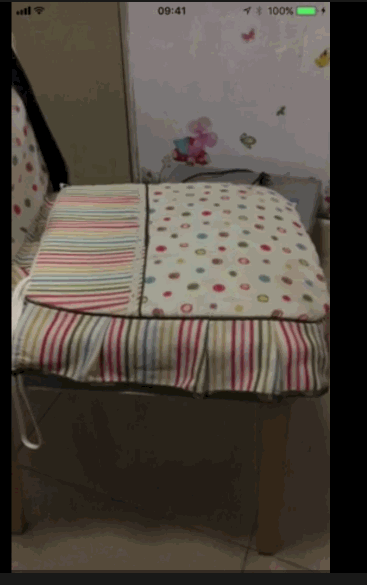转载请注明出处:http://www.jianshu.com/p/fc40ed0080dd1.1-ARKit捕捉平地实现流程介绍1.2-完整代码1.3-代码下载地址在介绍完ARKit详细的工作原理以及所有的API之后,最令人期待的干货终于要来了!废话不多说,先看效果桌子上的绿萝太孤独了,给它来一个郁金香陪伴一下吧~0901
来源: ARKit从入门到精通(8)-ARKit捕捉平地 – 坤小的专栏 – CSDN博客
- 转载请注明出处:ARKit从入门到精通(8)-ARKit捕捉平地
- 1.1-ARKit捕捉平地实现流程介绍
- 1.2-完整代码
- 1.3-代码下载地址
- 在介绍完
ARKit详细的工作原理以及所有的API之后,最令人期待的干货终于要来了! - 废话不多说,先看效果
- 桌子上的绿萝太孤独了,给它来一个郁金香陪伴一下吧~

0901.gif
- 在椅子上摆瓶花吧~

0902.gif
1.1-ARKit捕捉平地实现流程介绍
- 平地捕捉需要一点时间,ARKit内部会进行比较复杂的算法,所以有时候可能没有那么快,需要耐心等待。
- 1.搭建自定义ARKit工作环境,详情请见笔者
ARKit从入门到精通(3)-ARKit自定义实现这篇文章 - 2.配置
ARSessionConfiguration捕捉平地事件,实现ARSCNViewDelegate监听捕捉平地回调 - 3.通过
ARSCNView的代理获取平地锚点ARPlaneAnchor的位置,添加一个用于展示渲染平地的3D模型(上图中一个红色的平地)- 在前面小节笔者已经强调过,ARKit框架只负责捕捉真实世界的图像,虚拟世界的场景由SceneKit框架来加载。所以ARKit捕捉到的是一个平地的空间,而这个空间本身是没有东西的(一片空白,只是空气而已),要想让别人能够更加真实的看到这一个平地的空间,需要我们使用一个3D虚拟物体来放入这个空间
- 4.开启延迟线程,在平地的位置添加一个花瓶节点
- 此处一定要注意:花瓶节点是添加到代理捕捉到的节点中,而不是AR试图的根节点。因为捕捉到的平地锚点是一个本地坐标系,而不是世界坐标系
- 核心代码介绍
#pragma mark -搭建ARKit环境
//懒加载会话追踪配置
- (ARSessionConfiguration *)arSessionConfiguration
{
if (_arSessionConfiguration != nil) {
return _arSessionConfiguration;
}
//1.创建世界追踪会话配置(使用ARWorldTrackingSessionConfiguration效果更加好),需要A9芯片支持
ARWorldTrackingSessionConfiguration *configuration = [[ARWorldTrackingSessionConfiguration alloc] init];
//2.设置追踪方向(追踪平面,后面会用到)
configuration.planeDetection = ARPlaneDetectionHorizontal;
_arSessionConfiguration = configuration;
//3.自适应灯光(相机从暗到强光快速过渡效果会平缓一些)
_arSessionConfiguration.lightEstimationEnabled = YES;
return _arSessionConfiguration;
}
#pragma mark -- ARSCNViewDelegate
//添加节点时候调用(当开启平地捕捉模式之后,如果捕捉到平地,ARKit会自动添加一个平地节点)
- (void)renderer:(id <SCNSceneRenderer>)renderer didAddNode:(SCNNode *)node forAnchor:(ARAnchor *)anchor
{
if(self.arType != ARTypePlane)
{
return;
}
if ([anchor isMemberOfClass:[ARPlaneAnchor class]]) {
NSLog(@"捕捉到平地");
//添加一个3D平面模型,ARKit只有捕捉能力,锚点只是一个空间位置,要想更加清楚看到这个空间,我们需要给空间添加一个平地的3D模型来渲染他
//1.获取捕捉到的平地锚点
ARPlaneAnchor *planeAnchor = (ARPlaneAnchor *)anchor;
//2.创建一个3D物体模型 (系统捕捉到的平地是一个不规则大小的长方形,这里笔者将其变成一个长方形,并且是否对平地做了一个缩放效果)
//参数分别是长宽高和圆角
SCNBox *plane = [SCNBox boxWithWidth:planeAnchor.extent.x*0.3 height:0 length:planeAnchor.extent.x*0.3 chamferRadius:0];
//3.使用Material渲染3D模型(默认模型是白色的,这里笔者改成红色)
plane.firstMaterial.diffuse.contents = [UIColor redColor];
//4.创建一个基于3D物体模型的节点
SCNNode *planeNode = [SCNNode nodeWithGeometry:plane];
//5.设置节点的位置为捕捉到的平地的锚点的中心位置 SceneKit框架中节点的位置position是一个基于3D坐标系的矢量坐标SCNVector3Make
planeNode.position =SCNVector3Make(planeAnchor.center.x, 0, planeAnchor.center.z);
//self.planeNode = planeNode;
[node addChildNode:planeNode];
//2.当捕捉到平地时,2s之后开始在平地上添加一个3D模型
dispatch_after(dispatch_time(DISPATCH_TIME_NOW, (int64_t)(2 * NSEC_PER_SEC)), dispatch_get_main_queue(), ^{
//1.创建一个花瓶场景
SCNScene *scene = [SCNScene sceneNamed:@"Models.scnassets/vase/vase.scn"];
//2.获取花瓶节点(一个场景会有多个节点,此处我们只写,花瓶节点则默认是场景子节点的第一个)
//所有的场景有且只有一个根节点,其他所有节点都是根节点的子节点
SCNNode *vaseNode = scene.rootNode.childNodes[0];
//4.设置花瓶节点的位置为捕捉到的平地的位置,如果不设置,则默认为原点位置,也就是相机位置
vaseNode.position = SCNVector3Make(planeAnchor.center.x, 0, planeAnchor.center.z);
//5.将花瓶节点添加到当前屏幕中
//!!!此处一定要注意:花瓶节点是添加到代理捕捉到的节点中,而不是AR试图的根节点。因为捕捉到的平地锚点是一个本地坐标系,而不是世界坐标系
[node addChildNode:vaseNode];
});
}
}1.2-完整代码
#import "ARSCNViewViewController.h"
//3D游戏框架
#import <SceneKit/SceneKit.h>
//ARKit框架
#import <ARKit/ARKit.h>
@interface ARSCNViewViewController ()<ARSCNViewDelegate,ARSessionDelegate>
//AR视图:展示3D界面
@property(nonatomic,strong)ARSCNView *arSCNView;
//AR会话,负责管理相机追踪配置及3D相机坐标
@property(nonatomic,strong)ARSession *arSession;
//会话追踪配置:负责追踪相机的运动
@property(nonatomic,strong)ARSessionConfiguration *arSessionConfiguration;
//飞机3D模型(本小节加载多个模型)
@property(nonatomic,strong)SCNNode *planeNode;
@end
@implementation ARSCNViewViewController
- (void)viewDidLoad {
[super viewDidLoad];
// Do any additional setup after loading the view.
}
- (void)back:(UIButton *)btn
{
[self dismissViewControllerAnimated:YES completion:nil];
}
- (void)viewDidAppear:(BOOL)animated
{
[super viewDidAppear:animated];
//1.将AR视图添加到当前视图
[self.view addSubview:self.arSCNView];
//2.开启AR会话(此时相机开始工作)
[self.arSession runWithConfiguration:self.arSessionConfiguration];
//添加返回按钮
UIButton *btn = [UIButton buttonWithType:UIButtonTypeCustom];
[btn setTitle:@"返回" forState:UIControlStateNormal];
btn.frame = CGRectMake(self.view.bounds.size.width/2-50, self.view.bounds.size.height-100, 100, 50);
btn.backgroundColor = [UIColor greenColor];
[btn addTarget:self action:@selector(back:) forControlEvents:UIControlEventTouchUpInside];
[self.view addSubview:btn];
}
#pragma mark -搭建ARKit环境
//懒加载会话追踪配置
- (ARSessionConfiguration *)arSessionConfiguration
{
if (_arSessionConfiguration != nil) {
return _arSessionConfiguration;
}
//1.创建世界追踪会话配置(使用ARWorldTrackingSessionConfiguration效果更加好),需要A9芯片支持
ARWorldTrackingSessionConfiguration *configuration = [[ARWorldTrackingSessionConfiguration alloc] init];
//2.设置追踪方向(追踪平面,后面会用到)
configuration.planeDetection = ARPlaneDetectionHorizontal;
_arSessionConfiguration = configuration;
//3.自适应灯光(相机从暗到强光快速过渡效果会平缓一些)
_arSessionConfiguration.lightEstimationEnabled = YES;
return _arSessionConfiguration;
}
//懒加载拍摄会话
- (ARSession *)arSession
{
if(_arSession != nil)
{
return _arSession;
}
//1.创建会话
_arSession = [[ARSession alloc] init];
_arSession.delegate = self;
//2返回会话
return _arSession;
}
//创建AR视图
- (ARSCNView *)arSCNView
{
if (_arSCNView != nil) {
return _arSCNView;
}
//1.创建AR视图
_arSCNView = [[ARSCNView alloc] initWithFrame:self.view.bounds];
//2.设置代理 捕捉到平地会在代理回调中返回
_arSCNView.delegate = self;
//2.设置视图会话
_arSCNView.session = self.arSession;
//3.自动刷新灯光(3D游戏用到,此处可忽略)
_arSCNView.automaticallyUpdatesLighting = YES;
return _arSCNView;
}
#pragma mark -- ARSCNViewDelegate
//添加节点时候调用(当开启平地捕捉模式之后,如果捕捉到平地,ARKit会自动添加一个平地节点)
- (void)renderer:(id <SCNSceneRenderer>)renderer didAddNode:(SCNNode *)node forAnchor:(ARAnchor *)anchor
{
if(self.arType != ARTypePlane)
{
return;
}
if ([anchor isMemberOfClass:[ARPlaneAnchor class]]) {
NSLog(@"捕捉到平地");
//添加一个3D平面模型,ARKit只有捕捉能力,锚点只是一个空间位置,要想更加清楚看到这个空间,我们需要给空间添加一个平地的3D模型来渲染他
//1.获取捕捉到的平地锚点
ARPlaneAnchor *planeAnchor = (ARPlaneAnchor *)anchor;
//2.创建一个3D物体模型 (系统捕捉到的平地是一个不规则大小的长方形,这里笔者将其变成一个长方形,并且是否对平地做了一个缩放效果)
//参数分别是长宽高和圆角
SCNBox *plane = [SCNBox boxWithWidth:planeAnchor.extent.x*0.3 height:0 length:planeAnchor.extent.x*0.3 chamferRadius:0];
//3.使用Material渲染3D模型(默认模型是白色的,这里笔者改成红色)
plane.firstMaterial.diffuse.contents = [UIColor redColor];
//4.创建一个基于3D物体模型的节点
SCNNode *planeNode = [SCNNode nodeWithGeometry:plane];
//5.设置节点的位置为捕捉到的平地的锚点的中心位置 SceneKit框架中节点的位置position是一个基于3D坐标系的矢量坐标SCNVector3Make
planeNode.position =SCNVector3Make(planeAnchor.center.x, 0, planeAnchor.center.z);
//self.planeNode = planeNode;
[node addChildNode:planeNode];
//2.当捕捉到平地时,2s之后开始在平地上添加一个3D模型
dispatch_after(dispatch_time(DISPATCH_TIME_NOW, (int64_t)(2 * NSEC_PER_SEC)), dispatch_get_main_queue(), ^{
//1.创建一个花瓶场景
SCNScene *scene = [SCNScene sceneNamed:@"Models.scnassets/vase/vase.scn"];
//2.获取花瓶节点(一个场景会有多个节点,此处我们只写,花瓶节点则默认是场景子节点的第一个)
//所有的场景有且只有一个根节点,其他所有节点都是根节点的子节点
SCNNode *vaseNode = scene.rootNode.childNodes[0];
//4.设置花瓶节点的位置为捕捉到的平地的位置,如果不设置,则默认为原点位置,也就是相机位置
vaseNode.position = SCNVector3Make(planeAnchor.center.x, 0, planeAnchor.center.z);
//5.将花瓶节点添加到当前屏幕中
//!!!此处一定要注意:花瓶节点是添加到代理捕捉到的节点中,而不是AR试图的根节点。因为捕捉到的平地锚点是一个本地坐标系,而不是世界坐标系
[node addChildNode:vaseNode];
});
}
}
//刷新时调用
- (void)renderer:(id <SCNSceneRenderer>)renderer willUpdateNode:(SCNNode *)node forAnchor:(ARAnchor *)anchor
{
NSLog(@"刷新中");
}
//更新节点时调用
- (void)renderer:(id <SCNSceneRenderer>)renderer didUpdateNode:(SCNNode *)node forAnchor:(ARAnchor *)anchor
{
NSLog(@"节点更新");
}
//移除节点时调用
- (void)renderer:(id <SCNSceneRenderer>)renderer didRemoveNode:(SCNNode *)node forAnchor:(ARAnchor *)anchor
{
NSLog(@"节点移除");
}
#pragma mark -ARSessionDelegate
//会话位置更新(监听相机的移动),此代理方法会调用非常频繁,只要相机移动就会调用,如果相机移动过快,会有一定的误差,具体的需要强大的算法去优化,笔者这里就不深入了
- (void)session:(ARSession *)session didUpdateFrame:(ARFrame *)frame
{
NSLog(@"相机移动");
}
- (void)session:(ARSession *)session didAddAnchors:(NSArray<ARAnchor*>*)anchors
{
NSLog(@"添加锚点");
}
- (void)session:(ARSession *)session didUpdateAnchors:(NSArray<ARAnchor*>*)anchors
{
NSLog(@"刷新锚点");
}
- (void)session:(ARSession *)session didRemoveAnchors:(NSArray<ARAnchor*>*)anchors
{
NSLog(@"移除锚点");
}
- (void)didReceiveMemoryWarning {
[super didReceiveMemoryWarning];
// Dispose of any resources that can be recreated.
}
/*
#pragma mark - Navigation
// In a storyboard-based application, you will often want to do a little preparation before navigation
- (void)prepareForSegue:(UIStoryboardSegue *)segue sender:(id)sender {
// Get the new view controller using [segue destinationViewController].
// Pass the selected object to the new view controller.
}
*/
@end1.3-代码下载地址
- *ARKit从入门到精通Demo:http://download.csdn.net/detail/u013263917/9868679
- 笔者已经将8、9、10三小节的代码合并成一个完整的小demo,供读者交流学习
 Mikel
Mikel

